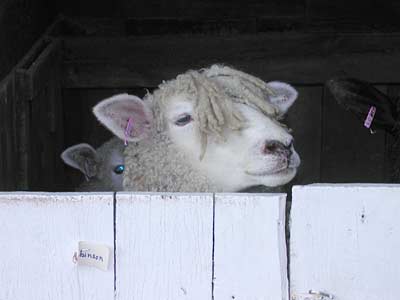Out in Leggett, CA, having just caught my breath after an hour of slow driving on winding mountain roads, I bought a kit of a midwestern farm windmill at the souvenier stand at Drive-Through Tree Park. It took me until Saturday evening to start it. As you will see from that link, Chief Honest John was not a native American chief but a navy CPO; but that’s another honest way to come by the title. At any rate, I did get going on the model. By now the frame is standing tall. Well, about eight inches tall.
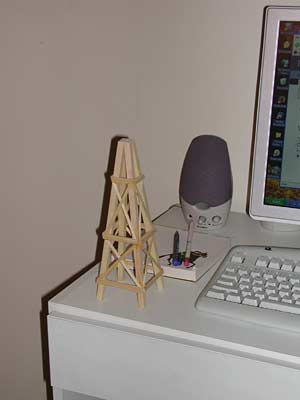
Return trip from Unity
Across the street from the MOFGA grounds (this is still on Oct. 14) we saw this sculpture
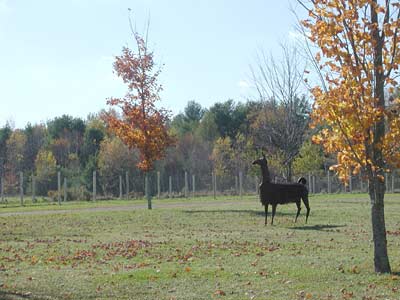
marking Northern Solstice Alpaca Farm. It didn’t seem to be open, and we had just got in the car and were psyched for moving a little, but there it is, and if we see them at the Fiber Fest next year we’ll know who they are. I didn’t see any yarn offered on their web site, just as well.
On the way to the apple day we had noticed a surprisingly large train depot in Unity, that is, surprisingly large for the size of the town. On the way back we stopped (notice the inconsistency — we must have only been psyched for moving two miles) to check it out. It’s the headquarters of a sightseeing rail line that seems to have rejuvenated that corner of the town.
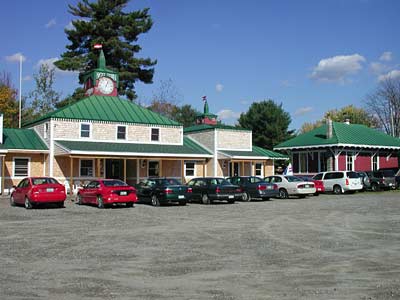
We walked over to the ticket office and noticed a train headlight shining on us from a hundred yards down the track. The morning foliage trip was just returning, its steam engine chugging along, driving wheels turning smoothly.
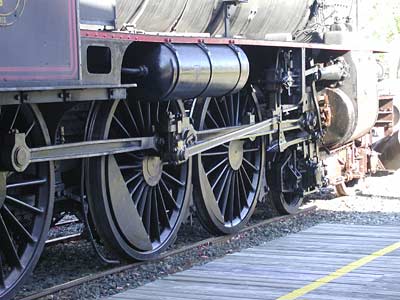
There’s no mistaking the power behind even a smallish steam locomotive when it goes past at a distance of a few feet. We think we’re pretty hot stuff today with electronic technology, but let’s pause a moment to admire the 19th and early 20th century mechanical engineers who designed those puppies without CAD systems and the machinists who built them without numerically controlled machine tools.
OK, we paused…
It was too late to consider a sightseeing trip right then, but we filed the Unity Depot, and the Belfast and Moosehead Lake Railway, in our memory for another time. We wouldn’t even have to get up as early to get there when the train leaves as we had to get to Apple Day when it started, and this time we know the way.
Rather than backtrack to the turnpike, we took route 202 towards home. We were thinking we might stop for supper in Augusta, but we got there long before supper time.
Somewhere along the way, maybe near China, we passed a farmhouse with interesting stone monuments in the yard. I turned the car around at the next opportunity so we could get a closer look. Maybe someone who runs a granite quarry brought home factory reject stonework to display? The grass was mowed neatly around each piece of stone, so it’s a deliberate display. And for goodness sake, these are big heavy rocks, not the kind of thing someone just tossed in the back seat.
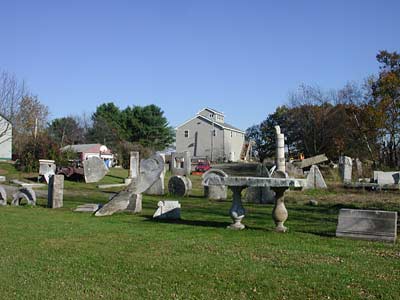
We stayed on route 202 into Lewiston/Auburn, where we stopped in Big Lots, got lots of interesting stuff (a $7- pair of dark glasses, because the sun was in my eyes, was the biggest-ticket item we got there) and asked directions to Lowe’s, and went to Lowe’s to use up a gift card I had got as a rebate on a ladder purchase. We had no trouble spending it, and loaded the car with a storage rack for garden tools, a new toilet seat (oops — too much information?), a garden rake to add to the storage rack, a case of bottled water, and more. By then it really was supper time. I took a couple of wrong turns trying to get to Ruby Tuesday’s and went through downtown Lewiston and Auburn another time. Unless there’s lots more construction and change of traffic patterns, I think I’ll be able to find Lowe’s on my own next time.
BBC story on alpaca raising in Peru
This is what I originally thought blogs were supposed to be about — find something interesting on the web and put up a link to it. The BBC news today had an article about alpacas, so here you go. It looks as though the people in Peru like alpacas even more than the people who raise them here do.
Orionid Meteors
When we got to Casco it was another gorgrous clear starry night. I’m not yet so used to being able to see the Milky Way on moonless nights that I take it for granted. I looked a while and didn’t see any meteors. In the early hours of Saturday I slept so poorly that I wasn’t about to get up before dawn to look for meteors. Saturday night, however, I psyched myself up to go out if I woke up to pee in the small hours. I looked at the sky long enough on Saturday evening to realize it was good and cold, so I set out warm clothes. Sure enough, at 2:58 (I always check the clock, just to see how it’s going) I woke up. Keeping one eye closed to stay dark adapted, I pulled pants and a sweater over my flannel pajamas, put a quilted shirt-jac and poplin jacket over that, and put on a knit hat (the first of the Jo Sharp silkroad aran tweed ones). I picked a chair off the porch, carried it down to the front yard, and sat down to look.
I never realized there were that many stars in Orion! I never realized there were a quarter so many. Even without meteors, it was gorgeous. I was hearing some sounds that might have been owl hoots, when a huge bird with rounded wings flew swiftly and silently right over my head towards the lake. I’m guessing great horned owl, but it could have been a barred owl just as well.
I did see three or four faint meteors and three good bright ones. It was the cold wind that drove me inside more than lack of meteors. The clock was reading 3:15 when I came in. Seven meteors in less than 15 minutes, not at all bad. When I looked at the thermometer when I really woke up around 8 AM it was reading around 35. It must have been well below freezing at 3 AM. Including the owl, getting up and out had been totally worthwhile.
Maine Apple Day
We went to the Great Maine Apple Day (or better, this link) at the Maine Organic Farmers and Gardners Association place in Unity on Saturday.
Well! It was different from the Fryeburg Fair! For one thing, there was no traffic. Partly that was because we left Casco just about at 8 AM to get to Unity before things started. Mostly it was because there 1/1000th as many people as at the Fryeburg Fair the previous weekend. I’m figuring 60,000 people at the Fryeburg fair and sixty at Apple Day. This was much more our speed. Look how empty the grounds were when we got there (and what a beautiful fall day it was)!
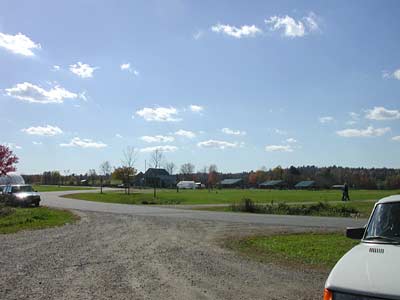
The event was in one large and two medium-sized rooms in one building. The large room was set up with display tables covered with apples; a small food table selling cookies, breadsticks, and soup; a cider press; and about four vendor booths.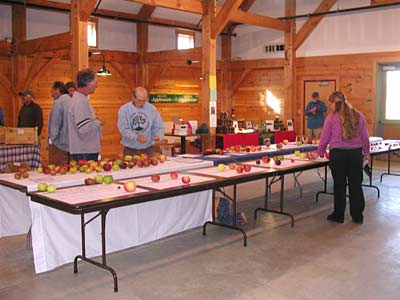
There were several, I think five, talks. We listened to presentations entitled, more or less, “wisdom from an organic orchardist”, “making hard cider”, and “growing fruit trees in Maine.” We skipped the ones on making apple wine and finding old apple trees.
I learned a reasonable amount about apples and apple trees from The Botany of Desire (which by coincidence I bought at Bridgton Books and read in Maine right after it came out, several summers ago.) If you haven’t read it, and you ever read nonfiction, run to your library and check it out.
If you don’t know, apples don’t grow true to type. The display table below showed an extreme example of a parent apple (tiny) and an apple (so big that the variety is called “wealthy”) from a tree that grew from its seed.
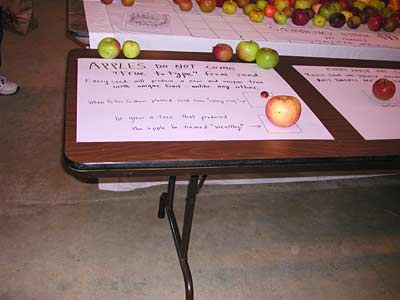
That is, the seeds from a Gala apple won’t grow into Gala apple trees. They won’t even all grow to produce the same variety of apples. Two seeds from the same Gala apple probably won’t produce apples that are much alike at all. In fact, no two apple seeds will grow into trees that produce the same kind of apples. If an eighteenth- or nineteenth-century farmer happened to grow from seed an apple tree that gave good apples, it was like winning the lottery. Shoots of that tree could be grafted onto rootstock from other varieties (grown just for the rootstock! the “growing fruit trees in Maine” talk showed us how that’s done) to produce more of the desirable apples, so those shoots could be sold for good money. All the MacIntosh apple trees in the world are grown by grafting shoots that trace back to one seed; same for Granny Smith, Gala, Fuji …
The other side of that is, there were more varieties of apples than you’ve ever heard of on display on two or three tables in Unity on Saturday. The Botany of Desire talks about the diversity of apple trees that are found in the apple forests of Kazakhstan, where they originated, but seeing the diversity in front of you is a different story entirely.
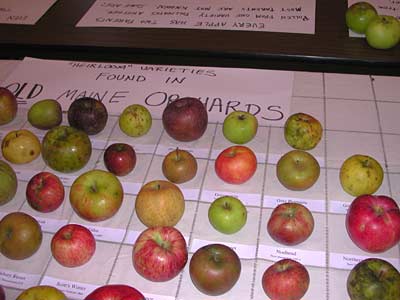
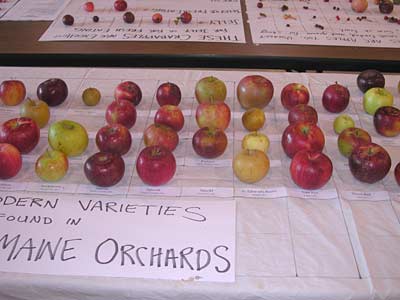
And not just on display. One table had a couple dozen paper plates, each with two or three apples of different varieties, and a paring knife for every four or so plates. You were invited to cut a slice of as many as you wanted and sample them.
Of course, one of the sponsors of the event was a nursery that will sell you any of a huge selection of apple trees, and they’d love nothing better than for everyone who came to the event to order one each of every variety. But there are easier and more secure ways of making a living than growing apple varieties; the people who do it really love it and want to preserve old as well as commercially grown apple varieties. Because the same way that you can only grow a new Gala from a shoot from an old Gala, when the last Briggs Auburn tree dies, there will never be another one.
The best audience participation part was the cider mill. There’s a big crank you can turn to grind up apples. A woman about our age, that is, aging hippie age, (the place was full of people who probably were hanging around Cambridge in the ’60s and ’70s), was tossing apples into the hopper while I cranked. Ground up apples, including peel, stems, and seeds, dropped into one of two cider press barrels below. When one was reasonably full, you turned the other crank to lift the top of the press up from the other barrel, dumped the pressed-out remains (that’s called pomace. Your free vocabulary lesson for the day) to put on a compost heap somewhere, and moved the pulp-filled container under the press. Turn the other crank down, and fresh cider flows out the bottom.
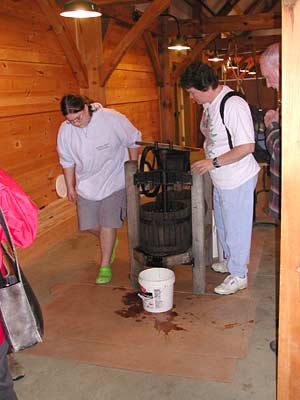
Crabapple Liqueur recipe
From a handout from Fedco Trees that we picked up at the Apple event yesterday
4 quarts crabapples cut in half
4 C granulated sugar
26 oz vodka
Fill 4 quart container 3/4 full with crabapples. Pour sugar over top. Add vodka. Add remaining crabapples. Put lid on. Let stand on counter or in cupboard.
Turn jar upside down then right side up once a day for one week. Let stand one month. Strain through a sieve. Discard apples. Strain liqueur through four layers of cheesecloth. Makes approx. 6 cups.
I started that recipe on Oct. 15, but filled a 350 ml jar rather than a gallon jar, and only used about 4 oz of vodka.
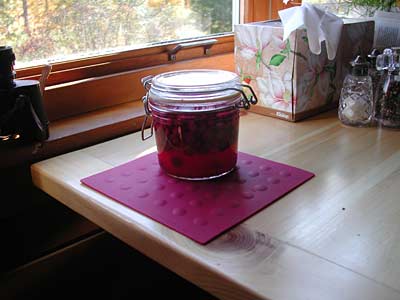
That’s what it looked like a week later. There’s much more liquid and much less crabapple than there was at the start; see the comment. The jar was pretty much packed full of crabapples at the start.
If it’s much of any good, I’ll try a bigger jar next year. Goodness knows there were enough crabapples. It takes time to cut them in half, though.
Apple Crumble recipe, from Aunt Lee
She emailed us this yesterday. We still have more apples than we know what to do with, so we made the recipe, but we didn’t have ginger so our opinion won’t be a good indication of how the recipe is.
About 5 large apples, peeled and sliced
1/4 cup honey
2 tablespoons brown sugar
1/4 cup orange juice concentrate or the actual juice
1 tsp. ginger
2 tsp. cinnamon
1/4 tsp. nutmeg
1/4 tsp. cloves
3/4 cup canola oil
3/4 cup sugar
1 cup flour
2 tsp baking powder
Pinch salt
1 tsp. vanilla
1 large egg
Preheat oven to 350 degrees.
Toss apples, honey, brown sugar, orange juice and spices.
Place mixture in a 9×13 inch pan.
In a separate bowl, mix oil, sugar, flour, baking powder, salt, vanilla and egg to form a thick batter.
Drop by spoonfuls onto apple mixture.
Bake 45 minutes at 350 or until top is nicely browned.
Fryeburg Midway
You’re not really going to find a fair without a midway. There’s a pretty interesting article about the guy who owns and runs the midway for the Fryeburg fair on their website. He started working in carnivals when he was a kid, sleeping in people’s game booths as a watchman so the prizes (which they never intended for anyone to win, since the games were basically crooked) wouldn’t be stolen. He says “In those days the games were all crooked,” I guess implying that nowadays they’re not. They’re still so garish that Charley is cringing.
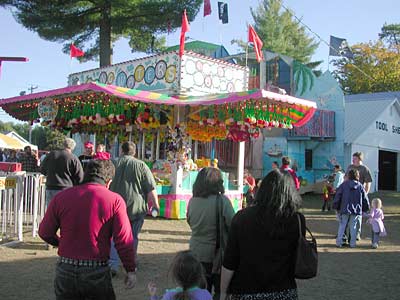
I remember riding on a ferris wheel at a carnival in Fair Haven VT sometime in the ’50s. It went up higher than I realized it was going to. I’m not sure I really liked it.
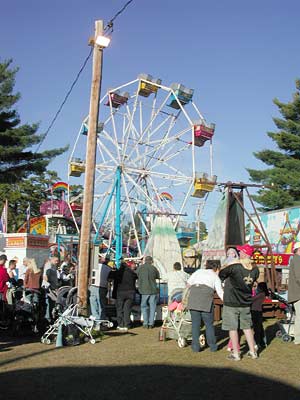
Emma wanted to do some rides. After we saw (and she petted) enough animals, we walked back to the kiddie rides area of the midway. Nicole was saying, “Now I’ll have to buy you some tickets for the rides,” when a man passing on his way home said, “Would you like tickets? I have a bunch left over,” and gave her a handful — must have been over $10 worth of tickets. So Emma got to go on four rides, and we still had tickets left over to pass on to someone else.

It was getting dark, late, and chilly, but after those good rides Emma was not ready to go home! Nicole and Charley tugged her along. We found our way back to our car, bounced down the power line dirt road to 302, peeked into two restaurants in Bridgton (both jammed, whether with leaf lookers or fairgoers we couldn’t tell) and ended up buying a rotisserie chicken at Hannafords to bring home for supper.
Fryeburg Home Ec Exhibits
Besides animal exhibits, the Fryeburg Fair has opportunities to exhibit, well, for instance, vegetable gardening, canning and knitting. I’m not sure what other cooking competitions or exhibits there are, because I had to zoom through that building to keep up with my family.
We’ve seen TV reports about giant pumpkin contests at big fairs. I can’t remember ever having seen a 400+ -pound pumpkin in person before. The big pumpkins even had names! I didn’t take any pictures of them, though.
The vegetable competition requires maybe three of a kind per entry. I guess the idea is that anyone can be lucky and grow one beautiful carrot, but if you can grow three matched beautiful carrots you have some idea of what you’re doing.
I just stopped long enough to take a blurry picture of a canning display and to admire the blue-ribbon-winning socks and sweaters.
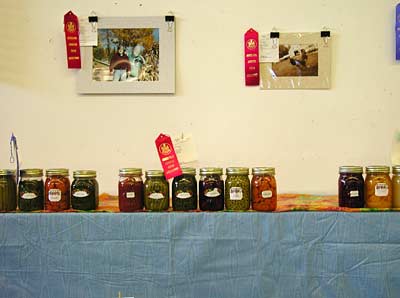
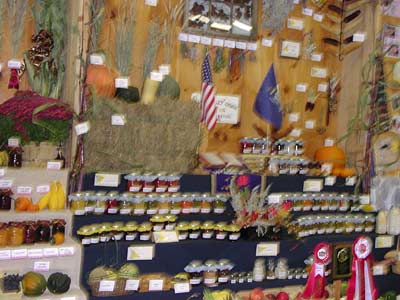
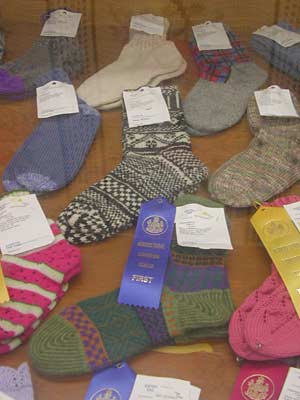
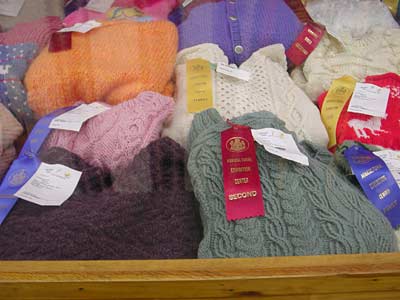
Fryeburg Agriculture Exhibits
The Fryeburg fair is after all an agricultural fair. It has lots and lots of animals on display. Maybe more people come to watch the harness racing and to ride the rides at the midway than to look at the animals, but I’m not at all sure. The barns were packed with so many visitors that it was slow walking through them to look at the animals. And there are a lot of barns!
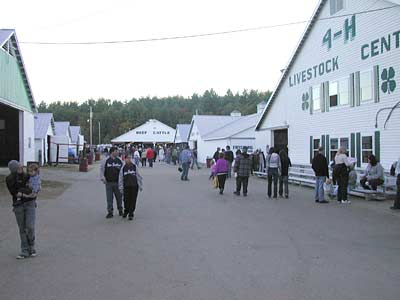
There’s a farm museum with old plows and other implements
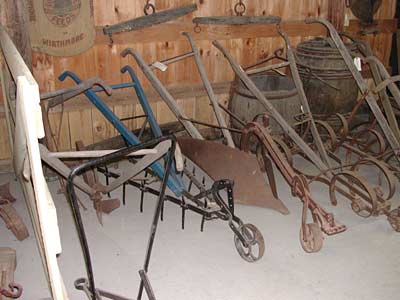
The pig barn was particularly crowded with people. We only got a quarter of the way down it before deciding it was too crowded for how interested we were.
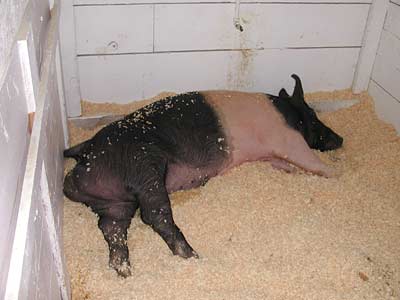
My camera takes a long time between when I press the shutter button and when it gets good and ready to take a picture. Animals often have turned around by that time, as did this prize hen:
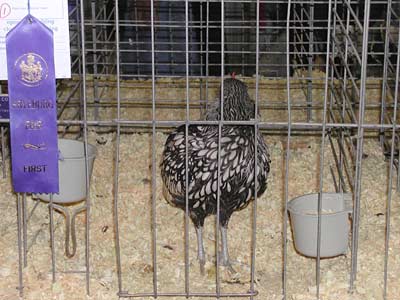
This rabbit is pretty well camouflaged against its bedding.

My favorite animal in the place was the sheep with dreadlocks.
